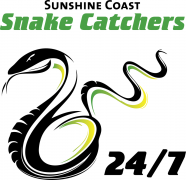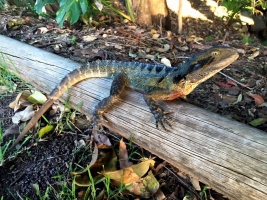Significance to Humans:
Not Dangerous but will bite if handled
General description:
Males are more robust than females. Prominent spines on head and along length of back, with a laterally compressed body and tail. Long powerful limbs. Olive green to brown in colour with short dark bands on the body, dark stripe behind the eye. Males have a distinctive red flush over the chest.
Average length:
Males 245mm, Females 190mm snout-vent length.
Habitat in SE Qld:
Occurs in all vegetation types generally in close proximity to water. Has successfully persisted throughout even the most modified riparian (river margin) habitats and is a common feature of inner city fauna.
General habits:
Australian water dragons are extremely shy in the wild. They are fast runners and strong climbers. When faced with a potential predator, they seek cover in thick vegetation, or drop from an overhanging branch into water. They are able to swim totally submerged, and rest on the bottom of shallow creeks or lakes for up to 90 minutes to avoid detection.
Diet:
Omnivorous feeding upon small reptiles, worms, frogs, insects, fruit, berries and molluscs.
Local distribution:
Found in all suburbs including the inner-city especially where aquatic habitats are represented such as resorts and botanical gardens.
Around the home:
Often observed sunning on rocks or banks surrounding water. A strong swimmer and will regularly take to water when disturbed. More tolerant of human presence near popular swimming holes, tourist spots and resorts.

